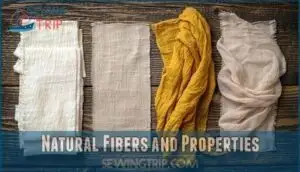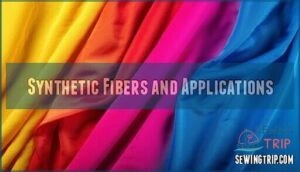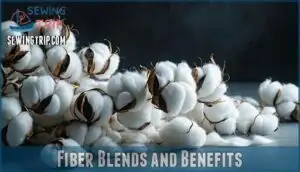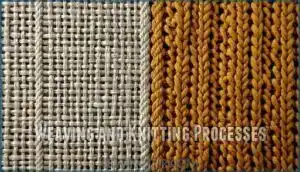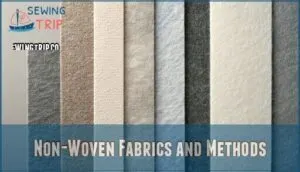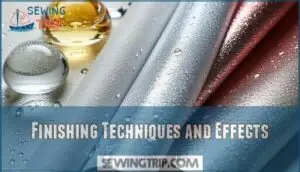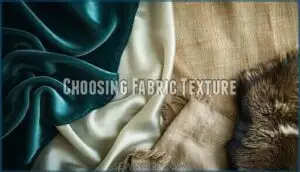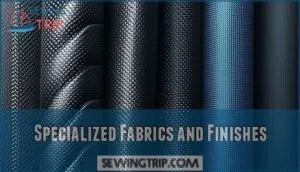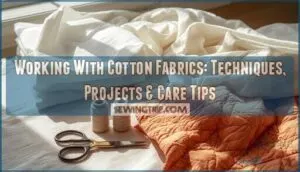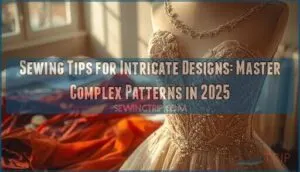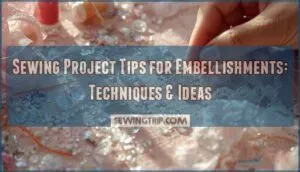This site is supported by our readers. We may earn a commission, at no cost to you, if you purchase through links.
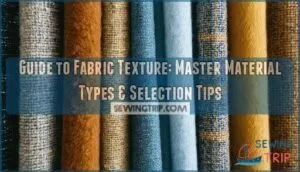 Your guide to fabric texture starts with understanding how surface feel affects both appearance and function.
Your guide to fabric texture starts with understanding how surface feel affects both appearance and function.
You’ll encounter smooth textures like silk and satin that drape beautifully, rough textures like burlap and tweed that offer durability, and soft textures like velvet and fleece that prioritize comfort.
The texture comes from fiber type, weave structure, and finishing techniques.
Natural fibers like cotton and wool create different textures than synthetics like polyester.
Weaving patterns, knitting methods, and special treatments all influence the final feel.
Understanding these basics helps you choose fabrics that match your project’s needs, whether you’re selecting upholstery that’ll withstand daily use or clothing that needs to move with your body, considering the final feel and the importance of natural fibers.
Table Of Contents
Key Takeaways
- You’ll identify fabric texture by feeling for smoothness, roughness, softness, or stiffness while examining weave patterns and fiber content labels to match materials with your project’s specific needs.
- You’ll choose natural fibers like cotton and wool for breathability and comfort, synthetics like polyester for durability and wrinkle resistance, or blends that combine the best properties of both.
- You’ll select appropriate textures based on purpose – smooth fabrics like silk for formal wear, rough textures like denim for durability, soft materials like velvet for comfort, and stiff fabrics for structured garments.
- You’ll maintain fabric quality by following proper care instructions, washing in cold water to preserve texture, and choosing higher-quality materials with longer fibers to prevent pilling and extend lifespan.
Fabric Texture Basics
You’ll quickly discover that fabric texture plays a vital role in how your clothing looks, feels, and performs in different situations.
Understanding the basic texture categories helps you make smart choices whether you’re shopping for everyday wear or special occasion pieces.
Smooth Textures and Luxury
Smooth fabric texture transforms everyday clothing into luxurious experiences.
Silk’s natural sheen and satin weaves create elegant draping that catches light beautifully.
These fabrics offer three key benefits:
- Silk properties provide natural temperature regulation and moisture-wicking
- Luxury blends combine durability with premium feel and appearance
- Microfiber finishes deliver wrinkle resistance while maintaining smoothness
Expensive fabrics like silk luxury materials and smooth synthetics elevate your wardrobe’s sophistication effortlessly.
Rough Textures and Durability
Grab a handful of tweed and you’ll instantly feel why rough fabric texture means business.
Tweed characteristics include dense weaving that withstands decades of wear, while wool resilience keeps garments looking fresh season after season.
Canvas strength makes it perfect for heavy-duty applications, and denim durability has made jeans a wardrobe staple worldwide.
Corduroy texture adds visual interest while maintaining excellent wear resistance, proving that durable fabrics don’t sacrifice style for substance.
Soft Textures and Comfort
You’ll find soft fabric texture creates an immediate sense of wellbeing when it touches your skin.
Velvets sensory impact comes from its plush pile, while chenilles cozy appeal makes loungewear irresistible.
These therapeutic fabric textures trigger feelings of security and comfort.
Soft fabric texture promotes relaxation through gentle fabric hand feel, making materials like velvet ideal for home environments where softness matters most.
The rise of these comfortable materials can be traced back to ancient hand-weaving techniques that prioritized texture.
Stiff Textures and Formality
When you need formal design, stiff textures deliver structured silhouettes that command respect.
Organza applications in evening wear create dramatic volume, while stiff interlinings provide backbone for custom-made jackets.
These heavyweight fabrics maintain crisp aesthetics throughout wear, think of upholstery density – stiffer materials hold their shape like armor, making texture influence your professional presence.
Formal settings demand fabrics that won’t wrinkle or sag, which is why stiff materials are preferred.
Identifying Fabric Types
You’ll encounter three main fabric categories that each bring unique textures and performance features to your garments.
Understanding how natural fibers like cotton and wool differ from synthetic options like polyester, plus learning when blends work best, helps you make smarter fabric choices for any project.
Natural Fibers and Properties
Cotton stands as the world’s most popular natural fiber, offering exceptional Cotton Breathability that keeps you comfortable all day.
Cotton’s natural breathability makes it the world’s go-to fabric for all-day comfort and everyday wear.
Its soft texture absorbs moisture naturally, making it perfect for everyday wear.
Linen brings impressive Linen Strength that surpasses cotton while providing cooling comfort in hot weather.
Wool Insulation traps air effectively, creating warmth without bulk.
Silk Drape flows beautifully, giving garments an elegant appearance.
These natural fibers showcase unique fabric properties that synthetic materials often struggle to replicate completely.
Synthetic Fibers and Applications
Synthetic fibers revolutionize fabric performance through engineered properties.
Polyester durability dominates global markets at 54%, offering wrinkle resistance and colorfastness. Nylon activewear excels in strength-to-weight ratios, while acrylic warmth mimics wool affordably.
Rayon softness provides silk-like drape, and spandex stretch enhances functionality. These synthetic fibers resist shrinking, fade less, and dry quickly—perfect for demanding applications from sportswear to industrial uses.
Their production contributes to significant greenhouse gas emissions, raising environmental concerns.
Fiber Blends and Benefits
You’ll get the best of both worlds when you combine different fibers.
Fabric blends like cotton-polyester merge natural comfort with synthetic durability, creating materials that resist wrinkles while staying breathable.
These fiber combinations reduce costs compared to pure materials while enhancing performance.
Synthetic blends add strength to natural softness, giving you blended durability that handles daily wear better than single-fiber fabrics.
Fabric Production Techniques
Understanding how fabrics come to life helps you choose the right texture for your needs.
From weaving threads into sturdy cotton to adding special finishes that repel water, each production method creates unique textures with distinct properties.
Weaving and Knitting Processes
Two primary methods transform raw fibers into fabrics you’ll recognize.
Weaving interlaces yarns at right angles, creating stable woven fabric texture with distinct weave structures like plain, twill, and satin.
Knitting loops single yarns together, producing flexible knitted fabric texture with various knit stitches.
Modern weaving techniques use process automation for consistent fabric formation, while hybrid techniques combine methods to achieve specific fabric weight and performance characteristics.
The weave’s structure impacts fabric’s breathability and drape, as seen in the link to fabric’s breathability and drape, which is crucial for understanding the properties of woven fabrics, including their performance characteristics.
Non-Woven Fabrics and Methods
Beyond traditional weaving and knitting lies a fascinating world where fibers bond without interlacing.
Non-woven fabrics use chemical, mechanical, or thermal processes to create materials like felt through compressed fibers. These innovative bonding processes produce versatile textiles with unique fabric texture characteristics perfect for specialized applications.
A variety of non-woven goods are available for different uses.
- Felt Production: Compressed wool fibers create dense, durable material without weaving
- Bonding Processes: Heat, chemicals, or needling techniques fuse fibers together permanently
- Material Composition: Synthetic and natural fibers combine for enhanced performance properties
Future innovations in non-woven technology promise exciting developments in sustainable fabric texture types and advanced applications.
Finishing Techniques and Effects
Finishing transforms raw fabric into polished material ready for use.
Dyeing processes add vibrant colors, while printing methods create patterns and designs.
Coating applications provide water resistance and durability.
Mechanical finishes like calendering smooth surfaces and add shine.
Chemical treatments enhance properties like stain resistance.
Metallic finishes and foiled finishes create eye-catching effects through fabric lamination techniques.
Certain processes require specialized fabric finishing equipment for fabric finishing and to achieve polished material.
Choosing Fabric Texture
When choosing fabric texture, you’ll need to match the material’s properties to your project’s specific requirements.
Consider three key factors: the intended purpose and use, environmental impact and sustainability, and long-term durability with maintenance needs.
Purpose and Intended Use
Choosing the right fabric texture depends on your specific needs and goals.
Consider garment functionality first – activewear requires moisture-wicking synthetics while formal wear benefits from structured materials.
Climate considerations matter too – lightweight linens work perfectly for summer, while wool provides winter warmth.
Activity appropriateness guides your selection – rough textures suit outdoor adventures, smooth fabrics complement office settings.
User preferences and aesthetic goals shape the final choice between clothing fabrics, upholstery fabrics, and home decor applications.
Sustainability and Eco-Friendliness
When choosing fabrics, you’ll want to take into account eco-friendly options that reduce environmental impact.
Organic cotton uses 91% less water than conventional varieties, while hemp produces 60% fewer emissions than synthetics.
Recycled fabrics divert millions of tons from landfills annually, and looking for sustainable fibers, eco-friendly dyes, and ethical production methods can help minimize textile waste while supporting responsible manufacturing practices.
Durability and Maintenance
When selecting fabrics, you’ll want materials that can handle your lifestyle’s demands without constant replacement. Durable fabrics resist wear from washing, stretching, and daily use, while proper care extends their lifespan substantially.
- Fiber Strength: Natural fibers like cotton and wool offer good abrasion resistance, while synthetic blends provide enhanced durability for high-wear items
- Washing Instructions: Follow care labels precisely – hot water damages delicate fibers, while cold water preserves color and prevents shrinkage
- Pilling Prevention: Choose tightly woven fabrics and turn garments inside-out when washing to reduce surface friction and maintain appearance longer. Considering the weave type, twill offers durability.
Specialized Fabrics and Finishes
You’ll encounter specialized fabrics designed for specific functions beyond basic comfort and style.
These engineered materials combine unique textures with advanced finishes to meet demanding performance requirements in everything from athletic wear to medical applications, including engineered materials and demanding performance.
Terry Cloth and Absorbency
Terry cloth stands out as the champion of fabric water absorption thanks to its unique weave structure.
**Terry cloth’s looped weave structure creates unmatched water absorption for superior moisture control.
This towelling terry features tiny loops that trap moisture effectively, making it perfect for towels and bathrobes.
The loops create maximum surface area for superior absorbency factors compared to alternative fabrics.
While drying time takes longer due to thickness, Terry cloth uses remain unmatched for applications requiring serious moisture control.
Velvet and Pile Fabrics
Velvet transforms any garment into a luxurious statement piece. This pile fabric creates depth through varying Pile Height – from short, dense velvet to dramatic Crushed Velvet with intentional wrinkles.
Understanding Velvet Durability helps you choose wisely:
- Faux Fur mimics animal textures without ethical concerns
- Corduroy Wales create structured ridges for casual wear
- Traditional velvet offers unmatched elegance for formal occasions
Each fabric texture serves different purposes, making pile fabrics versatile choices.
Satin and Wrinkle Resistance
Based on its lustrous appearance and smooth hand-feel, satin delivers elegance through its distinctive weave structure.
Originally crafted from silk, modern satin uses synthetic fibers like polyester that enhance antiwrinkling properties through specialized fabric finish treatments.
| Satin Properties | Fiber Composition | Care Methods |
|---|---|---|
| Lustrous surface finish | Silk, polyester, rayon | Low-heat ironing |
| Smooth fabric texture | Synthetic blend options | Gentle washing cycle |
| Natural drape quality | Traditional silk base | Professional cleaning |
The weave impact creates satin’s signature shine while wrinkle treatments during manufacturing reduce maintenance needs.
Understanding these characteristics helps you select appropriate satin fabrics for your specific projects.
Water Repellency and Fire Retardancy
Beyond smooth satins lies fabric’s protective power.
Water repellency and fire retardancy transform ordinary textiles into performance materials through specialized coating applications and fireproofing chemicals. Flame-resistant fabrics are essential in firefighting gear for protection against flames.
- Polyester fibers melting instead of igniting when exposed to flames
- Hydrophobic coatings beading water droplets across fabric surfaces
- Fluorine-free treatments maintaining breathability while repelling moisture
- Laboratory testing standards verifying fabric safety performance
- PU-backed materials combining durability with environmental impact considerations
These textile surface properties extend coating lifespan through proper care, making specialized fabrics essential for protective clothing, outdoor gear, and industrial applications where safety meets functionality.
Antimicrobial Finishes and Benefits
Antimicrobial finishes ward off bacteria, viruses, and fungi on fabric surfaces.
These specialized treatments prevent degradation, discoloration, and staining while maintaining fabric texture integrity.
You’ll find them essential in healthcare textiles and everyday performance fabrics where hygiene matters most.
These finishes are available for purchase online.
| Feature | Healthcare Applications | Consumer Benefits |
|---|---|---|
| Antimicrobial Effectiveness | Hospital gowns, bed linens | Odor control, freshness |
| Finish Durability | Withstands sterilization cycles | Maintains protection through washes |
| Skin Sensitivity | Hypoallergenic formulations | Gentle on sensitive skin |
| Environmental Impact | Biodegradable options available | Eco-friendly treatment choices |
| Application Methods | Spray, pad, or dip processes | Integrated during manufacturing |
These fabric applications require rigorous testing to verify their bactericidal activity and minimal inhibitory concentration values, ensuring reliable fabric benefits across various performance fabrics.
Frequently Asked Questions (FAQs)
How do you identify fabric and texture?
You’ll identify fabric by examining its texture through touch and sight.
Feel for smoothness, roughness, softness, or stiffness.
Check the weave pattern, fiber content on labels, and weight.
Notice how it drapes and responds to stretching.
How do you describe fabric textures?
Feel fabric like a detective reading clues.
You’ll notice if it’s smooth as silk, rough like sandpaper, or soft as a cloud.
Check how it moves, stretches, and feels against your skin.
How to get texture on fabric?
You create fabric texture through various techniques: weaving patterns, knitting structures, finishing processes like embossing or pleating, fiber blending, surface treatments, mechanical processes like brushing, and specialized construction methods.
How do you categorize fabrics?
You categorize fabrics by fiber type (natural, synthetic, blends), construction method (woven, knitted, non-woven), weight (lightweight to heavyweight), texture (smooth, rough, soft), and intended use (formal, casual, activewear).
How do fabric textures affect seasonal clothing choices?
Ironically, you’ll choose heavier wool for winter warmth yet crave lightweight linen’s breathability when summer heat strikes.
Smooth silk provides luxury for special occasions, while rough textures offer durability for everyday wear.
What causes fabric pilling and how to prevent it?
Fabric pilling happens when loose fibers tangle together from friction during wear and washing.
You’ll prevent it by washing clothes inside-out, using gentle cycles, and choosing higher-quality fabrics with longer fibers.
Can fabric texture impact skin sensitivity or allergies?
Your skin’s reaction to fabric hinges on texture roughness and fiber composition.
Rough textures like wool can irritate sensitive skin, while smooth fabrics like silk reduce friction.
Synthetic materials may trap moisture, causing reactions in allergy-prone individuals.
How do washing methods change fabric texture over time?
Washing methods dramatically alter your fabric’s feel and appearance through repeated cycles.
Hot water shrinks fibers while cold preserves texture.
Harsh detergents break down natural fibers, making them rougher.
Overdrying creates stiffness and reduces softness permanently, which can also affect the fabric’s overall texture.
Which textures work best for different body types?
Can you picture yourself as a walking canvas?
You’ll want smooth fabrics like silk to create sleek lines that elongate your silhouette, while rough textures add visual weight and dimension where you need it.
Conclusion
Mastering this guide to fabric texture puts you ahead of most shoppers who grab fabrics without understanding their properties.
You’ll save money by selecting materials that match your project’s demands rather than replacing poor choices later.
Your newfound knowledge of fiber types, weave structures, and finishing techniques transforms you from a casual buyer into an informed decision-maker.
Whether you’re choosing upholstery or clothing, you’ll confidently select textures that deliver the performance you need.
- https://www.thecreativecurator.com/types-of-textured-fabric/
- https://fashionsoulintl.com/blog/cotton-fabric-texture/
- https://fabricbysinghanias.com/blogs/fabrics-journal/the-psychology-of-fabric-textures-colors-and-their-impact-on-mood
- https://journals.sagepub.com/doi/10.1177/15589250241248761
- https://sewguide.com/best-fabric-with-texture/

